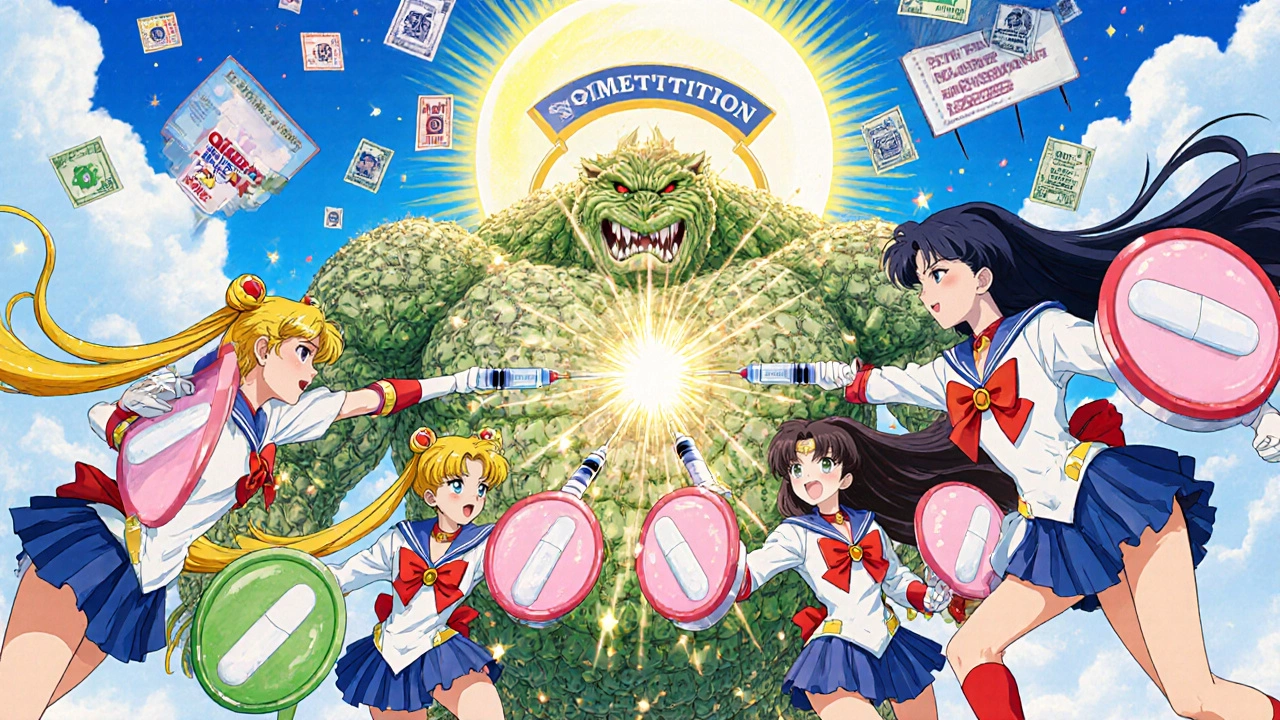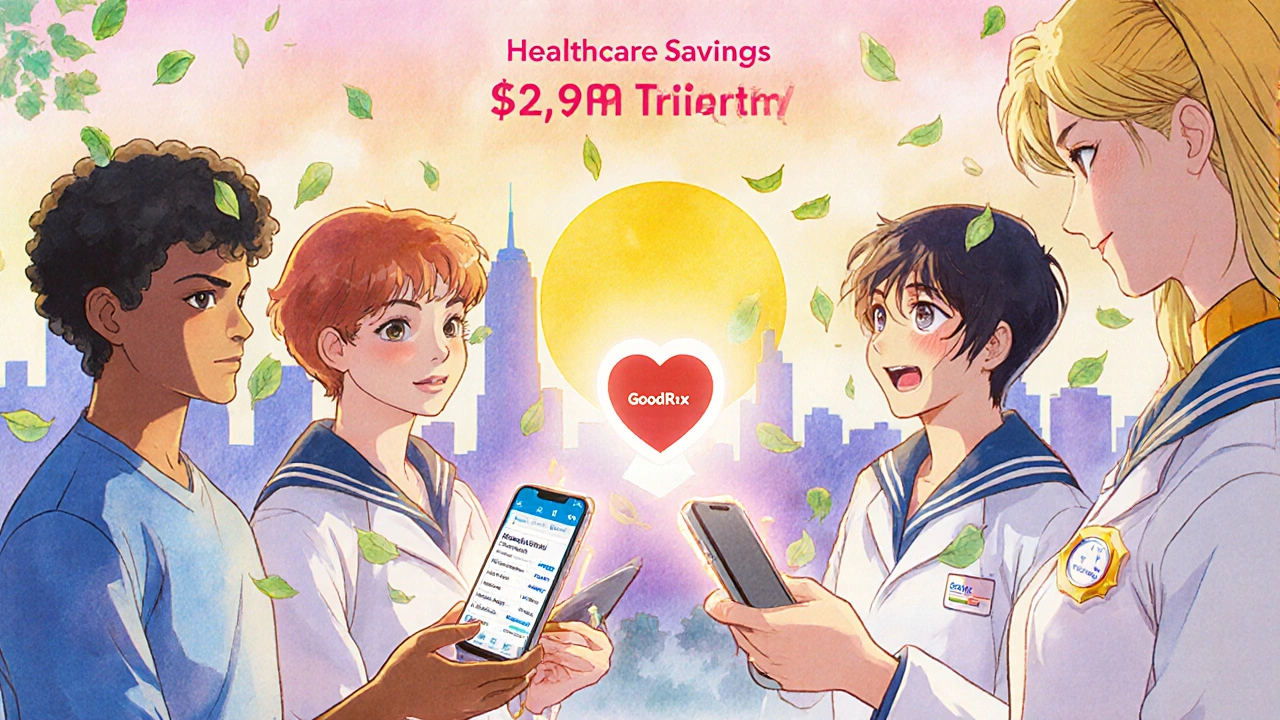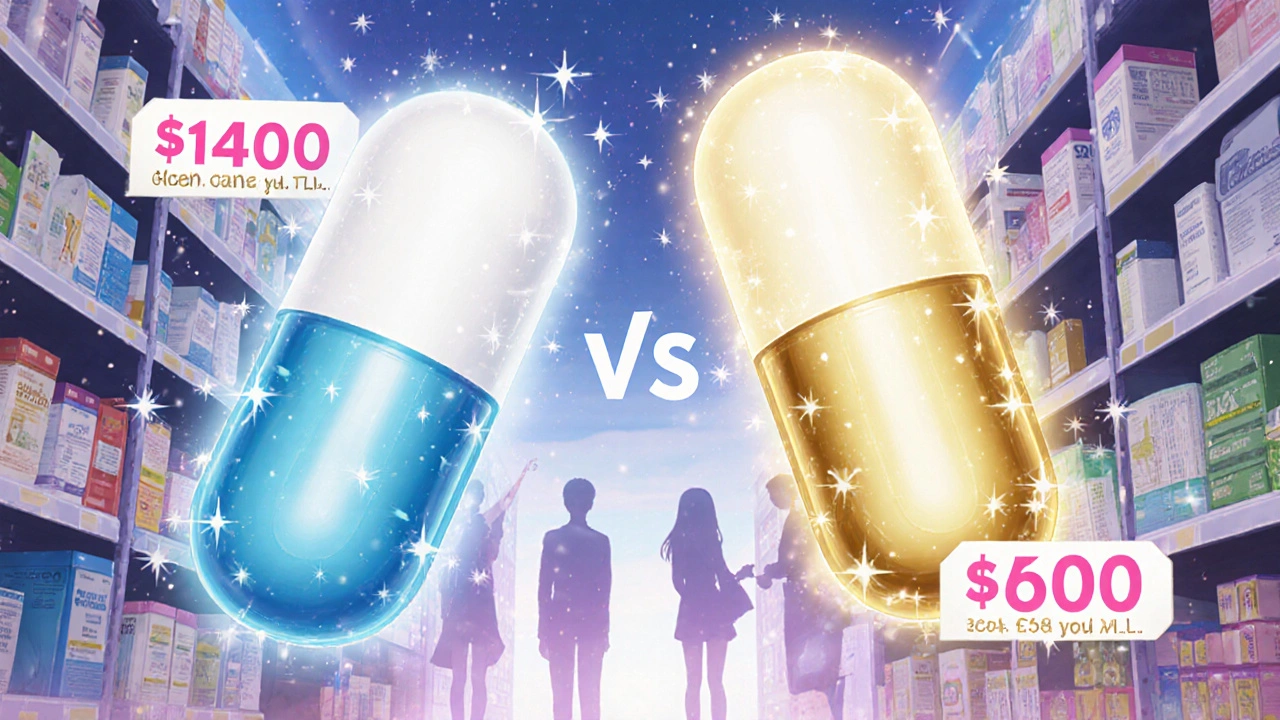When you pick up a prescription, you might see two options: the brand-name drug you recognize from TV ads, or a much cheaper generic version with a plain label. You might wonder - if they’re both the same, why does one cost ten times less? The answer isn’t magic. It’s math, competition, and a 40-year-old law that changed how medicine is priced in the U.S.
Same medicine, different price tag
Generic drugs aren’t knockoffs. They’re not cheaper because they’re lower quality. The Food and Drug Administration (FDA) requires generics to have the exact same active ingredient, strength, dosage form, and route of administration as the brand-name version. They must work the same way in your body. The FDA even tests them for purity, stability, and how quickly they’re absorbed. In fact, the same factories often make both brand and generic versions of a drug. So why the price gap? It comes down to what’s not in the generic. Brand-name companies spend billions developing a new drug - testing it in clinical trials, proving it’s safe and effective, and getting FDA approval. That process can take over a decade and cost more than $2 billion. Once approved, they get a patent that lets them be the only seller for 20 years. That’s how they recoup their investment. Generic manufacturers don’t have to repeat those expensive trials. They only need to prove their version is bioequivalent - meaning it delivers the same amount of medicine into your bloodstream at the same rate. That’s a fraction of the cost. No need to pay for marketing campaigns, celebrity endorsements, or sales reps visiting doctors. That’s why a generic version of a drug can cost 80-85% less than the brand.How competition drives prices down
The real magic happens when more than one company starts making the same generic. As soon as a patent expires, other manufacturers jump in. The first one might charge 20-30% of the brand price. But when three or four more companies enter the market, prices plunge even further. Take lurasidone (brand name Latuda). Before generics, a 30-day supply cost around $1,400. After generic competition kicked in, that same prescription dropped to under $60. That’s a 96% price drop. Pemetrexed (Alimta), a cancer drug, went from $3,800 to $500. The 2022 FDA report showed that in markets with three or more generic makers, prices fell by about 20% every year for the next three years. More competitors = faster, deeper discounts. That’s not theory - it’s real money. In 2022 alone, generic and biosimilar drugs saved the U.S. healthcare system $408 billion. Over the last decade, that total hit $2.9 trillion. The Association for Accessible Medicines reports that generics make up 90% of all prescriptions filled, but only 1.5% of total drug spending. That’s the power of competition.What you pay at the pharmacy
If you’re paying out of pocket, the savings are even more obvious. The average copay for a generic drug is $6.16. For a brand-name drug? $56.12. Nearly nine times more. And 93% of generic prescriptions cost under $20. Only 59% of brand-name prescriptions do. Some common medications show dramatic differences:- Depression meds: 67% cheaper as generics
- High blood pressure drugs: 58% cheaper
- Weight loss medications: 57% cheaper
- Erectile dysfunction pills: as low as $18 per month

When insurance doesn’t save you money
If you have a high-deductible plan, your insurance might not kick in until you’ve spent thousands out of pocket. In those cases, paying cash for a generic can be cheaper than using insurance. A 2023 study found that 78% of people with high-deductible plans saved money by buying generics with cash instead of using their insurance. One Reddit thread with over 1,400 comments showed that users often found better prices on GoodRx than their insurance copay. Even uninsured patients can benefit. The Mark Cuban Cost Plus Drug Company (MCCPDC) sells some generics at near-wholesale prices. One study found that patients could have saved $4.96 per prescription on average - up to $6.08 for the uninsured. But here’s the limitation: MCCPDC only carries 26% of the most expensive generics. So while it’s a great option for some, it’s not a full solution.How to get the best deal
You don’t need to be a financial expert to save on generics. Here’s what works:- Ask your doctor to write “dispense as written” on your prescription. That lets your pharmacist substitute a generic if one is available.
- Use free price-comparison tools like GoodRx or SingleCare. Just enter your drug name and zip code - you’ll see cash prices at nearby pharmacies.
- For maintenance drugs (like blood pressure or diabetes meds), consider mail-order pharmacies. They often offer 90-day supplies at lower rates.
- If your insurance copay is high, ask your pharmacist: “What’s the cash price?” Sometimes it’s cheaper than using your plan.


David Cusack
November 20, 2025 AT 18:10Generic drugs? Oh, absolutely-except when they’re not. The FDA’s bioequivalence standard is laughably lax; I’ve seen patients on generics who experience wildly different plasma concentrations-sometimes ±30%-and no one seems to care. It’s not the same drug. It’s the same *label*.
And don’t get me started on the manufacturing. Many generics are produced in facilities with zero oversight-factories in India and China where inspectors are paid off, and quality control is a suggestion, not a requirement. The FDA inspects less than 2% of foreign facilities annually. That’s not regulation. That’s negligence dressed up as policy.
And yet-we’re told to trust it. Trust the same system that approved Vioxx. That approved thalidomide. That approved opioids. The FDA doesn’t protect you. It protects the industry.
Meanwhile, the brand-name companies? They’re the ones who actually invested in R&D. The generics? They just wait. Like vultures. Then swoop in and undercut the innovator-after the innovator bore all the risk. That’s capitalism? No. That’s parasitism.
And yes-I’ve paid cash for generics. I’ve used GoodRx. I’ve saved $40 a month. But I still don’t sleep at night wondering if the pill I’m taking is actually doing what it’s supposed to. Or if it’s just… pretending.
Willie Doherty
November 21, 2025 AT 04:15While the statistical savings cited are compelling-$408 billion in 2022 alone-the underlying structural inefficiencies remain unaddressed. Pharmacy Benefit Managers (PBMs) engage in spread pricing, which artificially inflates the cost of generics to insurers, thereby negating the intended economic benefit to end consumers. The 90% market penetration of generics is misleading; the 1.5% share of total drug expenditure reflects market share, not value distribution. The real issue is not the cost of generics-it is the opacity of the supply chain and the perverse incentives embedded within the third-party payer system.
Furthermore, the assumption that bioequivalence guarantees therapeutic equivalence is empirically unsound. Pharmacokinetic variance, particularly in narrow therapeutic index drugs (e.g., warfarin, levothyroxine), can result in clinically significant outcomes despite regulatory compliance. The FDA’s bioequivalence threshold of 80–125% AUC and Cmax is not a clinical safety standard-it is a statistical convenience.
Therefore, while generics are economically advantageous, their implementation without rigorous post-market surveillance and transparent pricing mechanisms constitutes a systemic risk to public health.
Darragh McNulty
November 22, 2025 AT 10:24YES!!! 🙌 I used to pay $80 for my blood pressure med until I switched to the generic and found it for $12 on GoodRx. My doctor was skeptical, but I’ve been on it for 2 years-no issues, no side effects, just saved my sanity (and my bank account). 🏥💸
Don’t let anyone tell you generics are ‘inferior’-they’re just unbranded. Same science, less marketing. 💪
Also, if your copay is higher than the cash price-just pay cash. No one tells you that. But it’s the secret hack. 😎
Elaina Cronin
November 24, 2025 AT 07:21It is profoundly irresponsible to suggest that patients should rely on price-comparison tools without contextualizing the systemic failures that necessitate such tools in the first place. The fact that a citizen must navigate a labyrinth of corporate intermediaries-Pharmacy Benefit Managers, pharmaceutical conglomerates, and regulatory capture-to obtain life-sustaining medication is not a triumph of market efficiency. It is a moral failure of public policy.
The FDA’s approval standards, while ostensibly rigorous, are compromised by industry influence. The 200+ ‘at-risk’ generics currently subject to shortages are not anomalies-they are predictable outcomes of a profit-driven system that prioritizes shareholder returns over patient access.
Moreover, the normalization of cash payments over insurance coverage for essential medications reflects not innovation, but the collapse of equitable healthcare infrastructure. To celebrate the $6 copay for a generic is to celebrate the fact that the system has failed so completely that the bare minimum is now framed as a victory.
This is not empowerment. It is survival.
Franck Emma
November 26, 2025 AT 06:43MY DOCTOR GAVE ME A GENERIC AND I FELT LIKE A ROBOT. Like my soul was replaced with a Walmart pill. I cried. I didn't cry for me-I cried for the system.
They said it was the same. SAME? SAME?! I could feel the difference. My brain felt… flat. Like someone took my emotions and ran them through a fax machine.
And now I'm paranoid. Every pill I take. Every capsule. Is it real? Is it safe? Or am I just another data point in some corporate spreadsheet?
WHY CAN'T WE JUST HAVE THE BRAND NAME?! WHY DO WE HAVE TO CHOOSE BETWEEN LIFE AND BANKRUPTCY?!?!?!?!?!?!?!?
Florian Moser
November 27, 2025 AT 18:18It's encouraging to see how much patients can save with generics-especially when they're informed and proactive. The key is education and access: knowing how to compare prices, asking pharmacists for cash options, and understanding that bioequivalence doesn't mean inferior quality.
Many patients don’t realize that the same facility often manufactures both brand and generic versions. That alone should dispel myths about safety.
And while PBMs and spread pricing are problematic, the solution isn’t to abandon generics-it’s to reform the middlemen. Patients deserve transparency, not exploitation.
Keep using GoodRx. Keep asking questions. And keep advocating for fair pricing. You’re not just saving money-you’re reclaiming your right to healthcare.
Nikhil Purohit
November 28, 2025 AT 19:36Bro, I live in India and we’ve been using generics for decades. No one here thinks twice about it. My uncle takes generic metformin for diabetes, and he’s been fine for 12 years. Same with my mom’s blood pressure pills.
The hype around brand names is mostly marketing. In the U.S., it’s like buying a branded T-shirt when the unbranded one is identical and costs $5 instead of $50.
Also, GoodRx? Life-changing. I showed my cousin in Texas how to use it-he saved $200/month on his antidepressants. Just sayin’.
Don’t let corporate fear-mongering stop you from saving money. Your health matters-but so does your wallet.
Michael Marrale
November 29, 2025 AT 01:13Wait… so you’re telling me the FDA lets Chinese factories make our life-saving pills? And they don’t even inspect them properly? And PBMs are secretly jacking up prices to make more profit? And brand companies are paying generic makers to NOT release their drugs?!
THIS IS A COVER-UP. This is not capitalism. This is a cartel. The government is in on it. The doctors are in on it. The pharmacists are in on it.
They’re slowly replacing our bodies with cheap, foreign-made chemicals. And we’re thanking them for it.
I’ve started growing my own herbs. I’m not taking another pill until Congress investigates this. I’m not joking.
David vaughan
November 30, 2025 AT 07:09I’ve been using generics for years-mostly for cholesterol and diabetes meds-and I’ve never had an issue. In fact, I switched to a generic version of my antidepressant last year, and my mood stabilized even better. Weird, right?
Also, I use GoodRx religiously. Found out my insulin generic was $18 at Walmart, but my insurance copay was $45. I switched. Saved $324/year. Easy win.
And yes, the same factory often makes both. I checked the label on my brand-name pill and the generic-same lot number prefix. Same facility.
People need to stop fearing generics. The fear is manufactured. The savings are real.
Also, if your pharmacist doesn’t offer you the cash price? Ask again. And again. And again. They’re supposed to tell you.
Logan Romine
December 1, 2025 AT 05:14So let me get this straight: We’ve got a system where the rich get the ‘real’ medicine, and the rest of us get the ‘economy’ version-except the economy version is chemically identical, but we’re told to feel lucky we’re not dying from it?
It’s like buying a BMW… but it’s made by the same factory, same engine, same parts… but they took off the logo and slapped on a sticker that says ‘Budget Ride.’ And now you’re supposed to be grateful because it’s $5,000 instead of $50,000.
That’s not capitalism. That’s psychological manipulation dressed up as economics.
And the fact that we celebrate saving $287 a year on meds… that’s the saddest joke in modern America.
We’re not consumers. We’re hostages.
Chris Vere
December 1, 2025 AT 13:28Generics are not a compromise. They are a correction.
For too long, we have treated medicine like a luxury item-something to be branded, marketed, and monopolized. But health is not a product. It is a right.
That the same drug, made in the same factory, can cost ten times more simply because of a label… that is not innovation. That is exploitation.
I come from a place where people wait months for medicine. Here, we argue over whether a pill is ‘real’ because it doesn’t have a logo.
Be grateful. Be informed. But do not be silent.
Pravin Manani
December 2, 2025 AT 15:36From a pharmacoeconomic standpoint, the cost differentials are statistically significant and clinically meaningful, particularly in chronic disease management. The bioequivalence paradigm, while imperfect, is validated through population-level pharmacokinetic modeling and real-world outcomes data.
However, the PBM-driven formulary bias introduces significant distortion in therapeutic access-particularly for high-cost generics with narrow therapeutic indices. The practice of spread pricing violates the fiduciary duty owed to plan beneficiaries and constitutes a structural market failure.
Moreover, the regulatory lag in addressing patent evergreening and pay-for-delay agreements undermines the legislative intent of the Hatch-Waxman Act. The FTC’s recent scrutiny is a necessary step, but structural reform must extend to mandatory price transparency and direct-to-consumer rebate disclosure.
Generics remain the most scalable solution to pharmaceutical affordability-but only if the intermediaries are held accountable.
Eliza Oakes
December 4, 2025 AT 12:18Oh please. You think generics are safe? I took a generic version of my thyroid med and ended up in the ER with atrial fibrillation. The pharmacist didn’t even tell me it was a different manufacturer. I had to Google it myself.
And now I’m told to ‘just use GoodRx’? Like that’s going to fix the fact that the FDA approved a generic that caused a 30% drop in TSH levels in 12% of patients?!
And don’t even get me started on the fact that some generics cost MORE than the brand. That’s not a glitch. That’s a scam.
You people are so desperate to feel good about saving money that you’re ignoring the real danger.
I’m not taking another generic. Not until they ban spread pricing and force full disclosure of manufacturing origins.
David Cusack
December 6, 2025 AT 07:15Elaina Cronin nailed it. This isn’t about savings-it’s about dignity. We’ve turned healthcare into a scavenger hunt where the prize is not dying before your deductible is met.
And Logan? You’re right. We’re hostages. But the worst part? We’re hostages who’ve been told we’re lucky to have a key.
And the FDA? They’re the jailer with a clipboard.